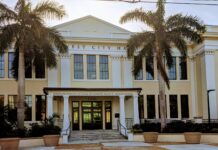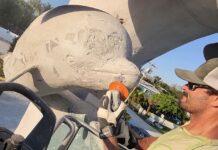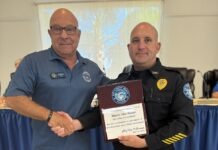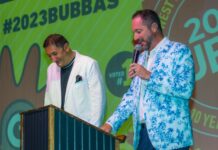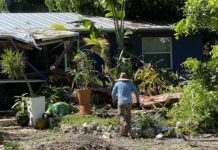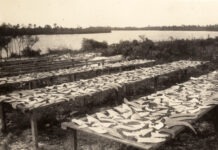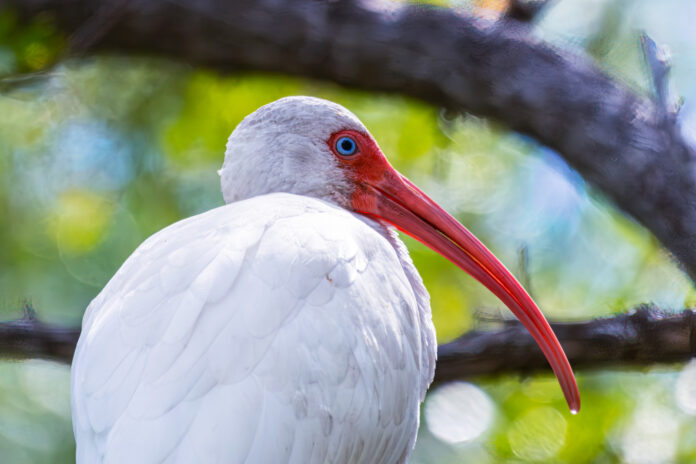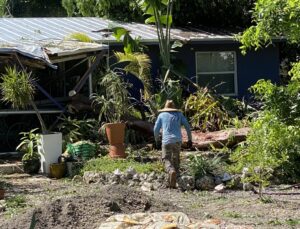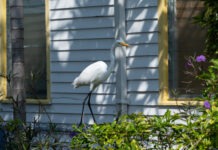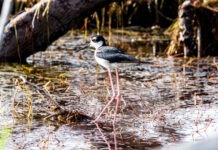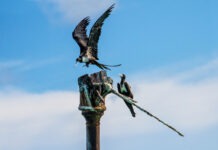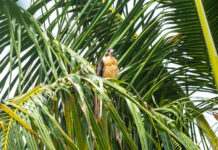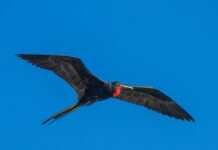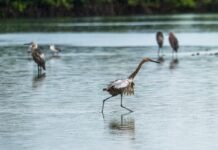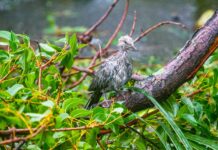The first thing you notice about a white Ibis is the bill, the long, sloping one that drops away from the face like the start of a Fibonacci spiral. At least it was the first thing I noticed. They were one of the birds I learned to identify early on when I moved to the Keys, back when I hardly knew how to identify any birds, possibly because they are so distinctive and so easy to tell apart. They are a southern bird if there ever was one.
As is often the case in the natural world, the long bill, no matter how pleasing the form, isn’t about aesthetics, but rather a form that facilitates function. The ibises use them to probe down into the soft ground, sometimes through an inch or two of water, looking for crabs and crayfish and the occasional worm.
I was thinking about using the word proboscis to describe their bill, but proboscis doesn’t just mean nose – it means articulated nose, like an elephant or tapir. Ibises’ bills are shot full with nerves, so they can feel their prey when they shove them into the water or underground, and the tips of the bill are actually slightly articulated, to allow them to grab things deep down with tweezer-like motions. Proboscis does sort of work as a descriptor, then, though I’m not totally sure if the definition that largely applies to mammals can fully make the leap to avifauna.
Ibises don’t always feed by probing – they will forage for small lizards and snails on dry land, as well as commit the occasional Dumpster dive, although seeing them do it is always a bit of a disappointment.
The ancient Egyptians considered their cousins, the African sacred ibis, to be, well, sacred. They even had a half-man, half-ibis “self-begotten” and “self-produced” immortal being named Djehuty (Thoth to the ancient Greeks) in their pantheon of gods. Djehuty is said to have revealed the art of writing to humans, created all math, science, magic and art, and enumerated the contents of all that is in heaven and on Earth, as well as the distances in between. Djehuty/Thoth was so associated with the African sacred Ibis that they occasionally skipped the half-man part and just portrayed him as wholly bird.
It may not be fair to compare one cousin species to another based on the religious belief built around them and the magic attributed to them. As we all know, cousins often take very divergent paths in life. Still, the white ibis’s Dumpster diving habits – it’s hard not to judge.
They do have some other impressive taxonomic cousins, the most spectacular of which I have seen being the scarlet Ibis. The adults of the species are a pinkish red that practically looks electrified. I would describe their plumage as something not found in nature if it weren’t for the fact that it is very much found in nature, one of the world’s more dramatic byproducts of natural selection. I used to see them often when I ran a bird tour company and would make multiple visits most years to Caroni Marsh in Trinidad. (The rum punch supplied by the folks at the Asa Wright Nature Centre could only enhance the intensity — or at least the viewers’ receptivity to it.) The color is an intensity I’ve never seen duplicated in a photograph, no matter how far someone pushes the saturation slider. It’s a color that has to be seen in real life to be fully appreciated.
Even on cloudy days, scarlet ibises seem to glow more brightly hued than anything around them, as if their plumage has some sort of additional power source. Compared to them, color-wise, our white ibises look about as dramatic as a ream of copy paper. Though this is kind of interesting because, shape wise, the two species look pretty much identical.
They are actually very closely related – some ornithologists consider them the same species – and they will occasionally interbreed in parts of Venezuela, where their habitats overlap. (Years ago a scarlet ibis escaped from a zoo on the west coast of Florida and interbred with a white ibis, creating a generation of what everyone called “pink ibises,” as well as several generations of less and less pink ibises.)
One of the weird things about birding, and I guess other things in life, is how eventually, when you see something very often, like, say, white ibises in the Florida Keys, it can be hard to keep noticing them, to keep seeing them with any kind of freshness. One of the things I fear most is getting inured to the magnificence of the world, of losing my ability to feel wonder. And I worry that if it was all about the shape and the bill plunging with the ibis, I might have lost my ability to feel any kind of spark when I see them.
Which is why I’m eternally grateful to my friend, Julie Heath, who got her Ph.D. studying them, and who years ago pointed out to me that I really needed to get a good look at their eyes – something I had neglected to do up until then. And once I got a good look, I saw it, the color – a small ringed dot of steely sky blue, a blue as bright and limpid as any Caribbean patch of sea.
I don’t think I’ll ever get enough of that color. I don’t think I can.
Interestingly, I saw a post on Instagram last week by Loren Ilvedson, half of the damn impressive twin Ilvedson brothers’ art collaboration, showing a screen print he made called “Ibis Bathing In Monroe County Tax Collectors Parking Lot,” which is pretty self-explanatory, if a bit ironically reductive of the beauty it so deftly portrays. In it he shows not just the final print, but the photo he took to capture the moment, an initial sketch, some of the printing process, and a note he made to himself about how to proceed. It’s just such a good simplified and impressionistic piece, especially the one bird he has, dipping its head into the puddle sideways, realistic in the way that birds don’t have suction in their bills, and often have to drink that way.
In the note he tells himself not to get detailed on the piece, to put the texture into the road and paint on the markings on the road, not the feathers or the puddle. He wonders whether to include the ibises’ eyes, and in the final piece, does not. Which absolutely works, the lack of details being more evocative than an excess of details.
Maybe, though, if he does a follow-up piece, he’ll do something cool with those eyes.

